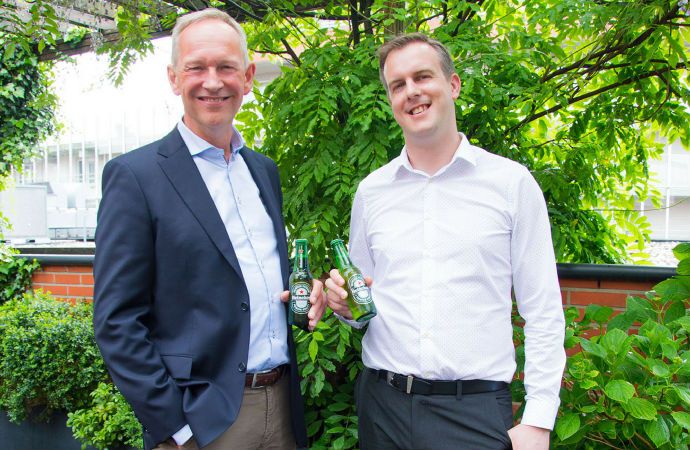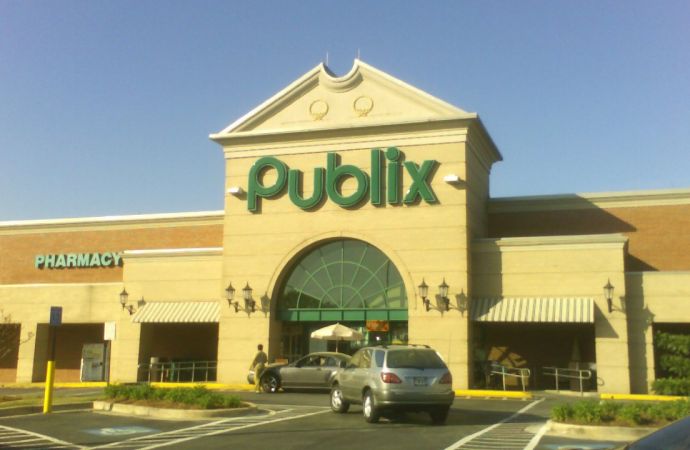Heineken is adopting hydrocarbons for all its new beer fridges worldwide. Accelerate Europe reports.

Hans Donker (l) and Graeme Houghton (r), HEINEKEN Global Procurement.
Convinced of the role that natural refrigerants can play in reducing its carbon footprint, Dutch multinational brewing giant Heineken is adopting hydrocarbons for all its new beer fridges worldwide.
In 2010, Heineken CEO Jean-François van Boxmeer gave his team the target of reducing the energy consumption of beer fridges. Thus began Heineken’s hydrocarbon journey.
“I got the briefing, ‘you need to buy green fridges’. That’s what we said, so I asked, ‘what’s a green fridge?’ It took them a few months to say, ‘best in class’. That wasn’t very specific,” says Hans Donker, Global Category Buyer – Fridges & Draught Beer Equipment, HEINEKEN Global Procurement.
“So we thought about it ourselves, and we said, ‘a green fridge is a fridge that has a hydrocarbon refrigerant, LED illumination, and a smart thermostat (energy management system)’,” he says.
Once the decision had been taken to opt for hydrocarbons, things moved quickly.
“In that first year, we saved 30% on energy consumption,” he adds.
We adopted hydrocarbons for two reasons – one, because they help to deliver the energy efficiency that we want; and two, because of their significantly lower GWP.”
– Graeme Houghton, Heineken
Proud to be green
Targeting 50% lower emissions from fridges by 2020, Heineken provides ‘green’ fridges whenever a fridge needs replacing and tests fridges against the Heineken Energy Efficiency Index (HEEI).
The brewer defines green fridges according to the following four principles: the use of hydrocarbon refrigerant, LED illumination, an energy management system, and energy efficient fans.
“We discovered hydrocarbons as part of our ‘Brewing a Better World’ programme. We adopted them for two reasons – one, because they help to deliver the energy efficiency that we want; and two, because of their significantly lower GWP compared to the existing refrigerants we used in our fridges,” says Graeme Houghton, Global Category Leader – Commercial Equipment & Servicing, HEINEKEN Global Procurement.
“So that was the pairing of it. We work with a number of cooling partners. We use an independent cooling advisory group, which helps us with the technology side of things, plus our cooling partners – the fridge manufacturers,” Houghton says.
To facilitate the optimal serving of Heineken and the other brands, whether in cans, bottles or draught, the company itself provides the infrastructure. “In the majority of cases, we own the fridges and draught beer equipment. We place it with our customers to help them serve the perfect Heineken,” Houghton says.
In 2017, almost 100% of the 137,818 new fridges Heineken bought had one or more (and in many cases all four) green features. CO2 emissions per fridge were 48% less than in 2010 (2016: 46%). Since the beginning of 2018, 100% of the fridges Heineken is purchasing are ‘green’.
“Because of the lifecycle of fridges, which we expect to be around about eight years, we anticipated that in order to reach our target in 2020, we needed to start immediately,” Houghton says.
The company started to use fridges based on hydrocarbons in 2010. “We expect that by 2020, the majority if not all of our fridge population will be green, with natural refrigerants,” Houghton says.
“It’s a lifecycle thing. The policy is ‘all new fridges’,” he explains.
Adopting natural refrigerants is helping to Heineken to improve the energy efficiency of its fridge portfolio. “When we started, we made enquiries with our fridge suppliers, asking them how many energy savings introducing hydrocarbon refrigerant, LED illumination, and a smart thermostat (energy management system) would deliver,” Donker says.
“They said, ‘if you do hydrocarbons, you’ll get 7% more efficient fridges; if you do LED, you’ll save 15%; and the energy management system gives another 15%’. That’s how it was described to us,” he explains.
We’ve got to the point where the green way – with hydrocarbons – is an accepted part of the Heineken way of life. And it’s reflected in our logo!”
– Graeme Houghton, Heineken
From Amsterdam to the world
With operations in so many countries, Heineken is mindful of the large contribution that adopting greener cooling practices can make to reduce its overall climate impact.
“Cooling is a significant part of our CO2 footprint. We’ve got over a million fridges out there in the field. We’re reducing their energy consumption by half,” says Donker.
“We have the power to change things. It takes time, model-by-model and area-by-area, until it becomes standard,” Donker says.
“We buy roughly 140,000 fridges a year,” says Houghton. “All the fridges we buy are hydrocarbons. We’re on a journey. It’s about changing our entire fleet.”
“The average lifetime of our fridges is about eight years, and we’re currently about eight years in. So if you do the maths – allowing for a bit of a dropout rate, it’s probably fair to say that we have about a million fridges in the market with natural refrigerants,” he estimates.
Economics were a major driver of the decision to use hydrocarbons. “If you switch in good time to the refrigerant that’s here to stay, then you can still repair those fridges,” says Donker, whereas “if you buy a R134a fridge now, then you’ll have an issue in the years to come”.
Heineken’s decision to use proprietary technology is an integral part of its wider strategy for reducing its carbon footprint. The company works with different fridge suppliers around the world.
The Blade – Heineken’s latest draught beer dispense innovation – has a keg volume of eight litres and is capable of chilling beer to 2°C, delivering beer at 3°C in the glass. It uses isobutane (R600a) as the refrigerant. “It’s already live in selected markets and will go further,” Houghton says.
The propane-based David XL Green draught system, meanwhile, stores and chills 20-litre kegs in a fridge directly below the counter so the beer does not have to travel far to the tapping point. Over 12,000 of the systems have been installed in 25 markets across Europe, Africa & the Middle East, Asia and the Americas.
David XL Green (double tap of beer) is the line extension of David Green (single tap of beer), the world's first 'green' draught beer system.
“It’s about deploying the right equipment in the right outlet, and applying the right technologies to make sure you’re as efficient as possible,” Houghton explains. “It’s a holistic approach.”
This is a shortened version of the cover story of the summer 2018 edition of Accelerate Europe magazine. Click here to read the full version.
Related stories


_1636620968.jpeg)
